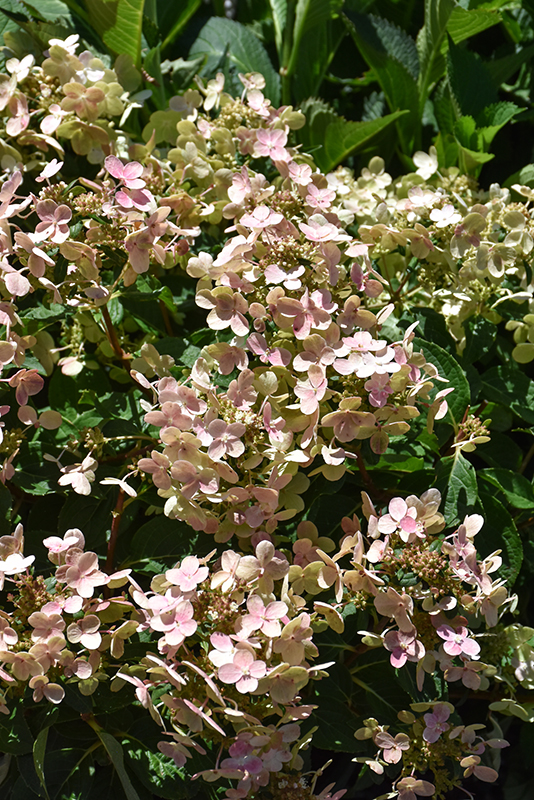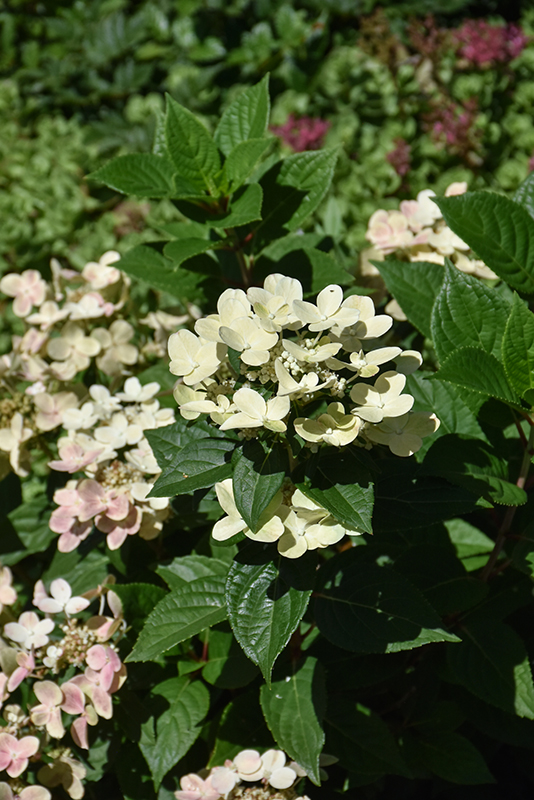Plant Finder
Early Evolution Hydrangea
Hydrangea paniculata 'AJ14'
Height: 30 inches
Spread: 24 inches
Sunlight:
![]()
![]()
Hardiness Zone: 5b
Brand: Concept Plants
Description:
A showy, early blooming variety featuring panicles of mixed sterile and fertile cream flowers which turn pink to red in late summer to fall; acidic soil results in violet-blue highlights; regular pruning recommended to maintain bushy appearance
Ornamental Features
Early Evolution Hydrangea features bold panicles of creamy white flowers with shell pink overtones at the ends of the branches from late spring to early fall, which emerge from distinctive white flower buds. The flowers are excellent for cutting. It has dark green deciduous foliage. The glossy pointy leaves do not develop any appreciable fall color.
Landscape Attributes
Early Evolution Hydrangea is a multi-stemmed deciduous shrub with an upright spreading habit of growth. Its relatively coarse texture can be used to stand it apart from other landscape plants with finer foliage.
This shrub will require occasional maintenance and upkeep, and is best pruned in late winter once the threat of extreme cold has passed. It has no significant negative characteristics.
Early Evolution Hydrangea is recommended for the following landscape applications;
- Accent
- Mass Planting
- Border Edging
- General Garden Use
- Container Planting
Planting & Growing
Early Evolution Hydrangea will grow to be about 30 inches tall at maturity, with a spread of 24 inches. It tends to be a little leggy, with a typical clearance of 2 feet from the ground. It grows at a medium rate, and under ideal conditions can be expected to live for 40 years or more.
This shrub does best in full sun to partial shade. It prefers to grow in average to moist conditions, and shouldn't be allowed to dry out. To help this plant achive its best flowering performance, periodically apply a flower-boosting fertilizer from early spring through into the active growing season. It is not particular as to soil type or pH. It is highly tolerant of urban pollution and will even thrive in inner city environments. Consider applying a thick mulch around the root zone in winter to protect it in exposed locations or colder microclimates. This is a selected variety of a species not originally from North America.
Early Evolution Hydrangea makes a fine choice for the outdoor landscape, but it is also well-suited for use in outdoor pots and containers. With its upright habit of growth, it is best suited for use as a 'thriller' in the 'spiller-thriller-filler' container combination; plant it near the center of the pot, surrounded by smaller plants and those that spill over the edges. It is even sizeable enough that it can be grown alone in a suitable container. Note that when grown in a container, it may not perform exactly as indicated on the tag - this is to be expected. Also note that when growing plants in outdoor containers and baskets, they may require more frequent waterings than they would in the yard or garden.
Disclaimer - This Plant Finder tool is an online resource representing many of the varieties that we carry over the course of the season, and is intended for informational purposes only. Inventory varies seasonally, so we cannot guarantee that every plant will be in stock at all times - please contact us directly for current availability. The Plant Finder tool does not include our entire selection of plants, so be sure to visit us to see varieties that may not be represented on this list.


